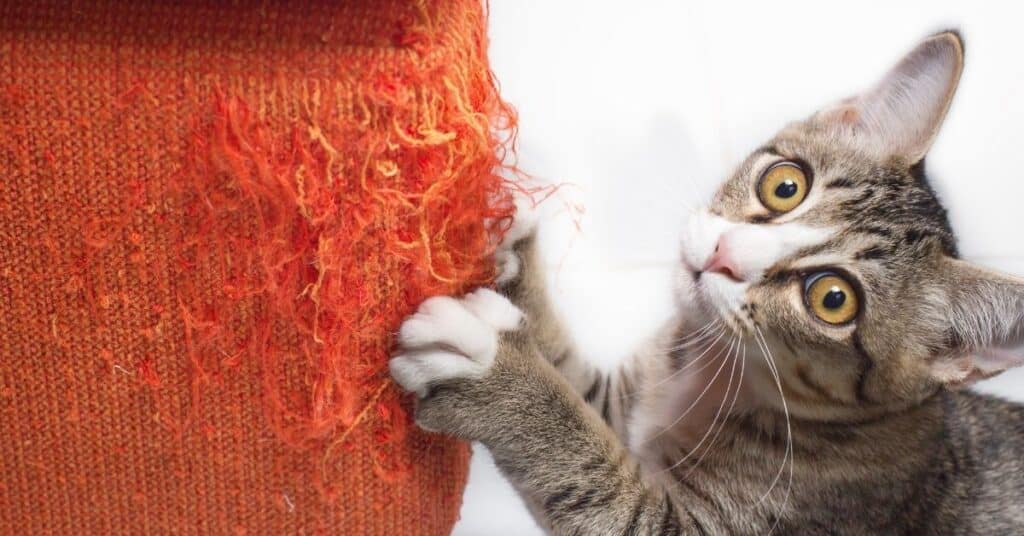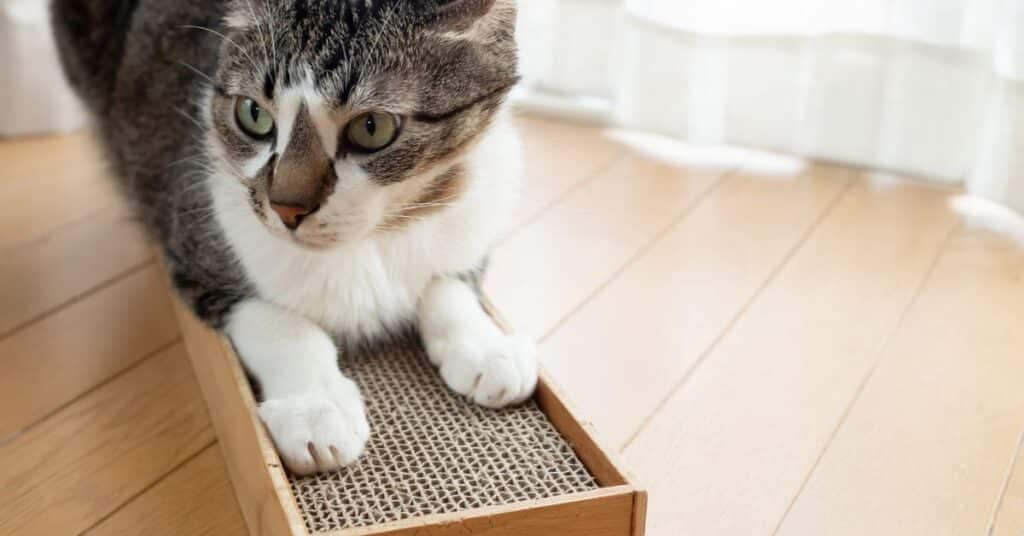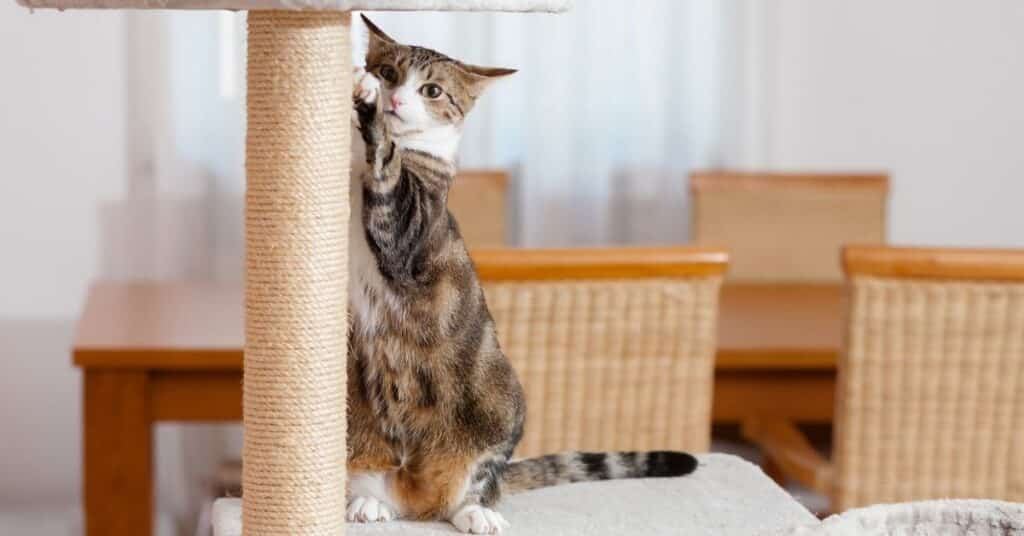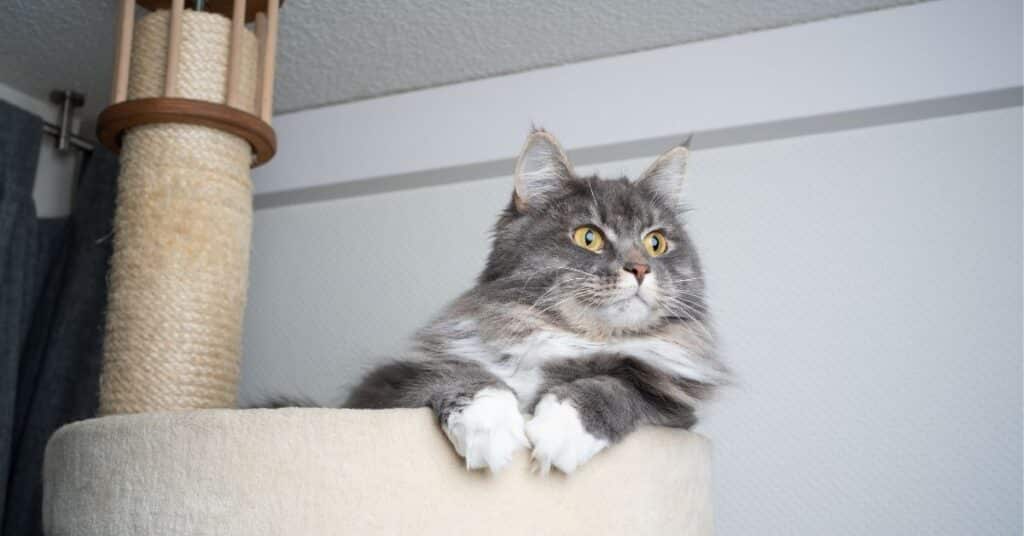Do you have a cat scratching up all your good furniture?
With some cats it’s seems like you take your eye off them for one moment and they destroy your couches.
The problem can result in hundreds and thousands of dollars of damage.
In this article, I’m going to help you understand why cats scratch and how to deal with it.
I am not a veterinarian and I recommend seeking the advice of a vet for any further questions. The advice in this article is not intended as medical advice.
Why do cats scratch?
Territory marking.
This is the main reason cats scratch. By tearing apart surfaces, it gives other people, cats, and animals a sign that the cat owns this spot.
Cats also spray urine and rub their head on objects to transfer scent.
A cats urine contains felinine, which a strong smelling chemical that helps with territory marking.
Why Do cats Scratch furniture?
It’s loosely woven.
Cats love scratching loosely woven fabric or any surface that breaks apart.
This gives a visual territory mark which is what signals ownership.
In nature, cats may scratch wear down the surface the same tree, rather than scratching a few spots.
Surfaces that don’t rip apart in the claws are less favorable for cats. This is one reason why your cats may ignore your scratching post.

Do cats scratch to condition their claws?
Maybe.
Cat’s don’t need to scratch to maintain and condition their claws. They do this using their teeth whilst grooming.
Declawed cats are also able to stretch tight muscles without scratching. This means scratching isn’t needed for stretching.
The main purpose of scratching is to mark territory. It’s to let other cats and animals know who owns an area.
It might play a small part in claw conditioning though.
Can I stop a cat scratching?
Nope.
In fact, trying to stop a cat scratching completely will be worse for their health. Stopping a cat from scratching results in behavioral issues.
Other methods for stopping scratching include declawing and/or tendonectomies. These are extreme measures to stop cats from being able to scratch.
Both of these surgical procedures result in health complications. These include:
- Pain
- Bleeding
- Decreased movement
In short, these approaches are extreme and negative experiences for cats. Instead, it’s better to get practical and start approaching the problem by adjusting your living area.
Many people opting for declawing haven’t tried other approaches first.
Let’s look at the solutions.
How to Stop Cats Scratching Your Furniture?
A scratching post or fabric.
The best way is to add a scratching post with loosely woven fabric and/or sisal rope. This type of material tears apart a little and helps your cat mark their territory.
That’s what cats aim to achieve with their scratching and why we want to help them with it. Let’s look at what you want in a scratching post.
What should you look for in scratching post?
Here’s what to go for:
Direction
Cats may prefer vertical or horizontal scratching.
The best way to find your cats preference is quite simple: watch what they do.
In the case of my cat, he liked horizontal AND vertical scratching. He was a very scratchy cat indeed.
If they like both, then you’ll want to get both a vertical and horizontal scratching option.

Build
A good scratching post should be sturdy enough to support your cats weight as they pull against it.
Check for customer reviews about any stability issues in the product.
Size
You want to make sure your cat has enough room to get maximum coverage with the claws.
Choose a scratching post that is at least 3 feet long.
Fabric
Cats prefer a loosely woven fabric that shreds easily in the claws. This gives cats the satisfaction that they are letting everyone know who’s boss in the house.
Survey based research suggests most cats prefer sisal (rope).
Where do I put my scratch post?
Buys areas.
Cats are more likely to want to mark territory in high traffic areas to make their mark.
Busy areas are areas your cat may see as areas that warrant territory control. Putting a scratching post near furniture helps divert attention.
Experiment with location and find what your cat likes best.

How many scratching posts do you need?
At least one.
You may need more than one scratching post if you have a multi-cat household. More scratching posts offers your cat a chance to mark their territory in all locations they use.
Always start by getting one scratching post to see if your cat likes the material and build.
If you’re still having issues, try a plastic rug runner over your couch. Although this is unsightly, it will stop the problem in the short term.
How to Make Your Cat Use Their Scratching Post?
Positive reward.
You want your cat to associate their new scratching post with a positive experience. To that end, you want to put it somewhere easy to access and reward use with treats.
You may try scratching the post yourself to encourage use, but your mileage may vary. Cat attractants like catnip may also help.

Should I Trim Nails To Stop A Cats Scratching?
Maybe.
Blunt nails do less damage than sharp claws. For this reason, it makes sense to trim your cats nails to help reduce damage to furniture.
Another option is you may opt for is soft paws. This is a plastic covering that stops the claws from damaging furniture.
They also protect you from scratch wounds when playing with your cat.
They need replacing every few weeks as they fall off, and you need time to apply them (which may be hard with a difficult cat).
Should I Declaw My Cat To Stop Them Scratching?
No.
This causes your cat pain and trauma. It’s an extreme measure that isn’t necessary if you improve your cats environment.
Researchers call this environmental enrichment. This is a process of making your house as ‘cat friendly’ as possible to simulate the wild environment.
This includes having areas to hide, climb, sleep, watch the birds (cat TV), and scratch.
Setting up everything the right way helps your cat have a better quality to cut down on stress.

Conclusion
Give your scratchy cat well placed cat scratching posts with loosely woven fabric. This is the key to help your cat mark their territory without ruining your furniture.
Claw protectors and nail trimming are also helpful ways to limit damage with scratchy cats.
Further reading:
